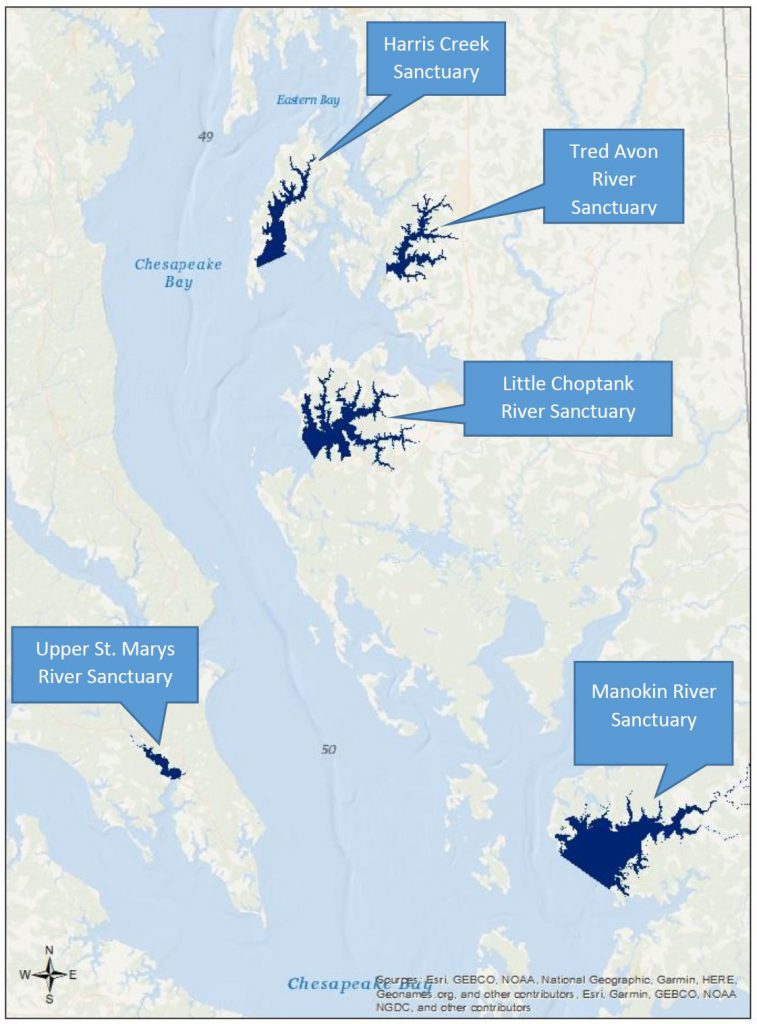Restoration Update: Status Report on the Chesapeake’s Essential Bivalve
The 2014 Chesapeake Bay Watershed Agreement committed Maryland and Virginia to restore native oyster habitat and populations in 10 bay tributaries by 2025—five in each state. The five Maryland tributaries containing these sanctuaries are:
• Harris Creek, a tributary of the Choptank River, Talbot County
• Little Choptank River, Dorchester County
• Tred Avon River, Talbot County
• Upper St. Mary’s River, St. Mary’s County
• Manokin River, Somerset County
For each of these oyster sanctuaries, a restoration plan has been or will be developed with the goal to restore a minimum of 50% of the currently restorable oyster habitat, constituting a minimum of 8% of historic oyster habitat.
Since 2011, restoration work has been ongoing and initial restoration has been completed on a total of 784.5 acres. Initial restoration has been conducted using one of two methods: either by planting a substrate base followed by planting hatchery produced spat-on-shell (called substrate and seed reefs), or by planting spat-on-shell directly onto suitable remnant reefs (called seed-only reefs).
 Each reef is slated to receive approximately 4 to 6 million spat-on-shell per acre during the initial restoration phase. Three years after reefs have initial restoration conducted, they are monitored. If monitoring shows that reefs have projected or lower-than-projected oyster density and biomass, they will receive the planned second spat-on-shell planting. If monitoring shows that reefs are faring better than projected, they will not require the second spat-on-shell planting. The second spat-on-shell planting is approximately 1 to 3 million spat-on-shell per acre.
Each reef is slated to receive approximately 4 to 6 million spat-on-shell per acre during the initial restoration phase. Three years after reefs have initial restoration conducted, they are monitored. If monitoring shows that reefs have projected or lower-than-projected oyster density and biomass, they will receive the planned second spat-on-shell planting. If monitoring shows that reefs are faring better than projected, they will not require the second spat-on-shell planting. The second spat-on-shell planting is approximately 1 to 3 million spat-on-shell per acre.
The five sanctuaries are in various stages of restoration as shown below. Three sanctuaries have tributary restoration plans completed (Harris Creek, Little Choptank River, and Tred Avon River), and restoration tributary plans are being developed for the remaining two sanctuaries (Upper St. Mary’s River and Manokin River).
Initial restoration has been completed for Harris Creek—currently the largest known oyster restoration—and is ongoing in the Little Choptank and Tred Avon rivers.
Harris Creek Sanctuary Status Update
The Harris Creek oyster restoration tributary plan was developed by the Maryland Interagency Oyster Restoration Workgroup in January 2013. In 2015, the initial restoration was completed with 350.9 acres or 58.5% of currently restorable oyster habitat restored. In 2019, the final secondary spat-on-shell planting restoration (20.3 acres) was planned. Due to the low hatchery production and adverse environmental conditions, this will occur in 2020, completing all planned restoration in Harris Creek. Continual monitoring will occur on all reefs according to the three-year and six-year monitoring schedule. So far, at year three of monitoring (2015-2017), 98% of reefs met the minimum threshold success criteria for oyster density and biomass.
Little Choptank River Sanctuary Status Update
The Little Choptank oyster restoration tributary plan was developed by the Maryland Interagency Oyster RestorationWorkgroup in February 2015. A total of 357.8 acres or 52.2% of currently restorable oyster habitat is planned to be restored. To date 351.1 acres are initially restored. The remaining 6.68 acres of initial restoration will be completed in the spring of 2020. Monitoring and planning for the second spat-on-shell restoration planting is ongoing.
Upper St. Mary’s River Sanctuary Status Update
The Upper St. Mary’s oyster restoration tributary plan was drafted by the Maryland Interagency Oyster Restoration Workgroup in 2019, and is in the final review phase. This plan is slated to be finalized by July 2020. The oyster sanctuary has 69.8 acres of currently restorable oyster habitat. There are 34.8 acres that are classified as premet (meet the oyster density and biomass targets and do not require initial restoration). There are 15.9 acres that are suitable for seed-only restoration, and 9.7 acres that are suitable for substrate and seed restoration. Initial restoration is anticipated to begin in spring 2020. The permit for in-water construction of substrate reefs from the Maryland Department of the Environment is pending.
Tred Avon River Sanctuary Status Update
The Tred Avon oyster restoration tributary plan was developed by the Maryland Interagency Oyster Restoration Workgroup in April 2015. A total of 130 acres or 51.7% of currently restorable oyster habitat is planned to be restored. To date 84 acres are initially restored. There are 39 acres remaining to be constructed with substrate by the U.S. Army Corps of Engineers, pending federal funding. The Department of Natural Resources will seed the 39 acres after construction. An additional 6 acres of seed-only restoration will be completed in 2020. All initial restoration is slated to be completed by 2021. Monitoring and the planned second spat-on-shell restoration planting is ongoing.
Manokin River Sanctuary Status Update
The Manokin River oyster sanctuary was officially accepted by the Chesapeake Bay Program’s Sustainable Fisheries Goal Implementation Team in June 2019. The Maryland Interagency Oyster Restoration Workgroup, in consultation with the Oyster Advisory Commission and local stakeholders, is developing a restoration plan. This plan is slated to be finalized by July 2020. Preliminarily, there are 584 acres of currently restorable oyster habitat in the sanctuary. A pre-construction bottom survey is ongoing to determine what type of restoration is suitable for each reef (seed-only or substrate and seed restoration). A minimum of 401 acres will be restored. Seed-only restoration is anticipated to start in 2020.
dnr.maryland.gov/fisheries/Pages/oysters/projects
Excerpted from the Progress Report on the Five Large-scale Oyster Restoration Sanctuaries submitted by the Maryland Department of Natural Resources to the Maryland General Assembly. Appears in Vol. 23, No. 1 of the Maryland Natural Resource magazine, spring 2020.


 1-888-373-7888
1-888-373-7888 233733
233733